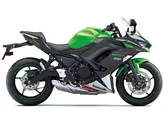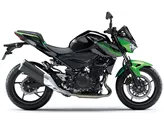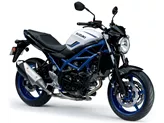Kawasaki Z 400 2023 vs. Kawasaki Z650 2017

Kawasaki Z 400 2023

Kawasaki Z650 2017
Overview - Kawasaki Z 400 2023 vs Kawasaki Z650 2017
The Kawasaki Z 400 model year 2023 and the Kawasaki Z650 model year 2017 are both naked bikes with similar engine types, in-line configurations, and liquid cooling systems. However, there are several key differences between the two models.
In terms of engine power, the Z 400 produces 45 HP, while the Z650 boasts a more powerful 68.2 HP. The Z650 also has a higher torque output of 65.7 Nm compared to the Z 400's 37 Nm. This means that the Z650 will likely offer faster acceleration and a more thrilling riding experience.
Both bikes feature fuel injection systems and have two cylinders. They also share similar suspension setups, with telescopic forks at the front and swing arms with monoshock absorbers at the rear. The Z 400 and Z650 both offer preload adjustment for the rear suspension, allowing riders to fine-tune the bike's handling characteristics.

Kawasaki Z 400 2023
In terms of braking performance, the Z650 has double disk brakes at the front with a diameter of 300 mm, while the Z 400 has a single disk brake with a larger diameter of 310 mm. Both bikes feature double-piston calipers and petal technology, which enhances cooling and reduces weight.
Both models come equipped with ABS, providing advanced rider assistance systems for increased safety. The Z 400 has a slightly narrower front tire width of 110 mm compared to the Z650's 120 mm. However, the Z 400 has a wider rear tire width of 150 mm compared to the Z650's 160 mm. Both bikes have 17-inch wheels.
The Z 400 has a slightly shorter wheelbase of 1370 mm, compared to the Z650's 1410 mm. The seat height of the Z 400 is also slightly lower at 785 mm, while the Z650 has a seat height of 790 mm. The Z 400 is lighter with a kerb weight of 167 kg, while the Z650 weighs 187.1 kg. Both bikes have fuel tank capacities of 14 l and 15 l, respectively.

Kawasaki Z650 2017
In terms of strengths, the Z 400 offers a lively engine, good chassis and brakes, easy handling, a grown-up look, and high-quality workmanship. The Z650, on the other hand, boasts an even power delivery, sporty chassis, compact dimensions, and a negative display.
As for weaknesses, the Z 400 has non-adjustable levers, which may limit customization options for some riders. The Z650, on the other hand, may be a little too small for tall individuals.
Overall, the Kawasaki Z 400 2023 and the Kawasaki Z650 2017 are both capable naked bikes with their own unique strengths and weaknesses. The Z650 offers more power and a sportier feel, while the Z 400 provides a more accessible and beginner-friendly option.
Technical Specifications Kawasaki Z 400 2023 compared to Kawasaki Z650 2017
Pros and Cons in comparison
Pros and Cons in comparison
Kawasaki Z 400 2023

A cool and sensible entry into the A2 class. The Kawasaki Z400 scores points all along the line with its instinctive handling and the in-line two-cylinder, which convinces with good response and sufficient power. You can't go wrong with this naked bike and you can overlook the fact that the levers are not adjustable - after all, costs have to be saved somewhere.
Kawasaki Z650 2017

The Kawasaki Z 650 is the tip of the middle class for small male and female riders. On its compact dimensions, you probably won't feel comfortable as a giant. Heart-warming feelings, however, come from the engine, which delights with a very smooth pull. On the chassis side, a Kawasaki-typical tight set-up was chosen, which finds a great compromise in everyday use. The negative display is very easy to read and is reminiscent of its predecessor, the ER-6n - very nice!
Price Comparison Avarage Market Price Kawasaki Z 400 vs Kawasaki Z650
There are a few key differences between a Kawasaki Z 400 2023 and a Kawasaki Z650 2017. In terms of price, the actual average price of a Kawasaki Z650 2017 is about 4% higher. Compared to Kawasaki Z650 2017 there are more Kawasaki Z 400 2023 bikes available on the 1000PS.de Marketplace, specifically 89 compared to 11. It takes less time to sell a Kawasaki Z650 with 76 days compared to 123 days for the Kawasaki Z 400. Since model year 2019 1000PS.de editors have written 8 reviews for the Kawasaki Z 400 and 31 reviews for the Kawasaki Z650 since model year 2017. The first review for the Kawasaki Z 400 was published on 02/10/2018 and now has more than 23,200 views. This compares to more than 25,000 views for the first review on Kawasaki Z650 published on 08/11/2016.



















